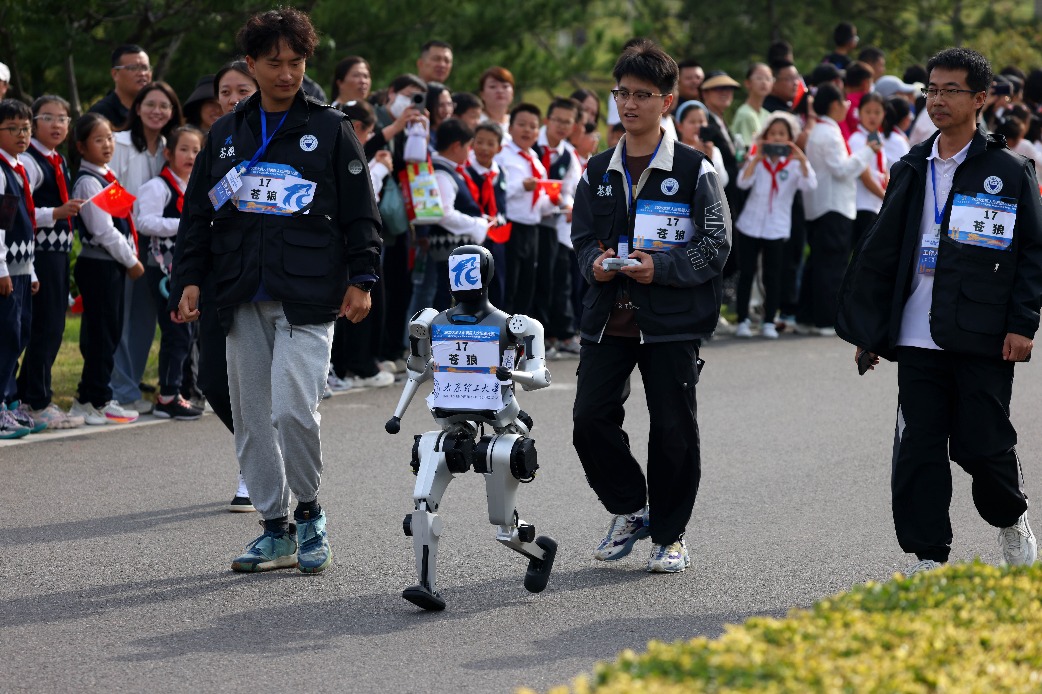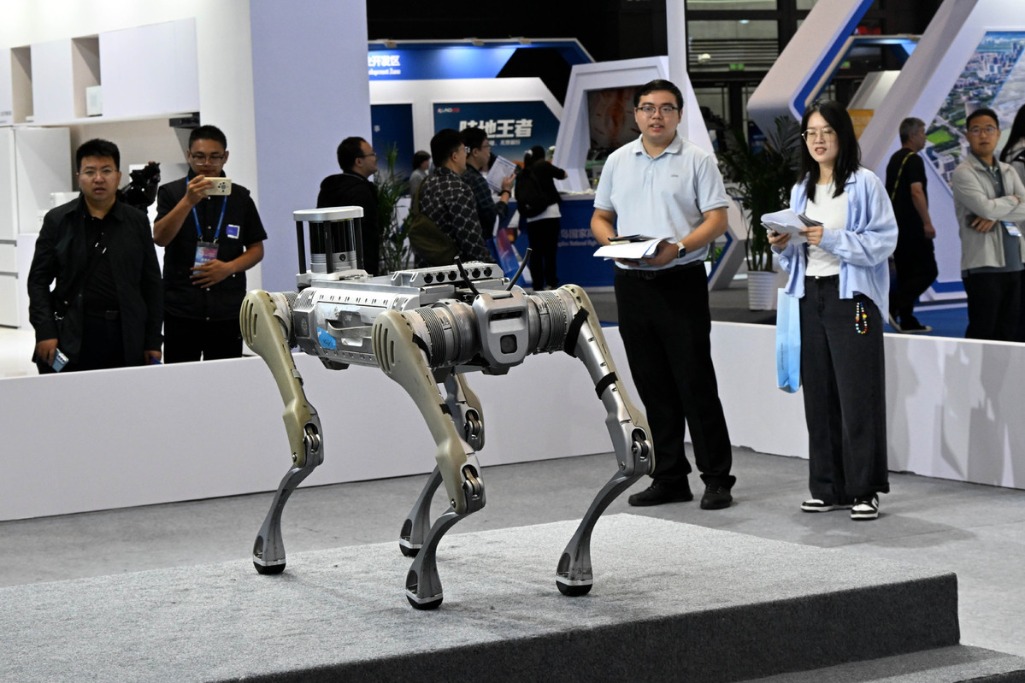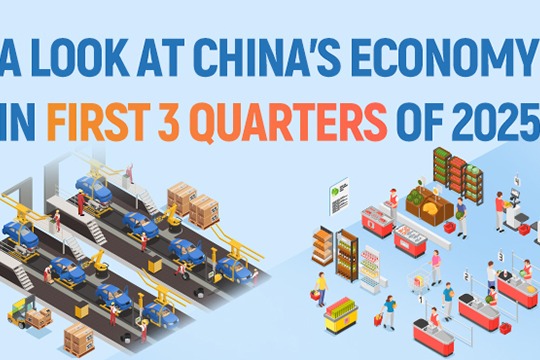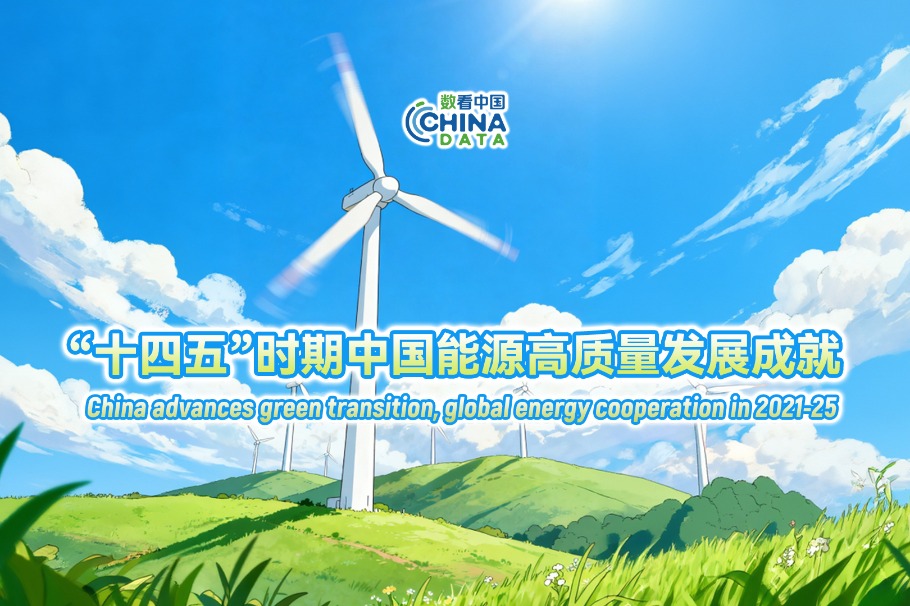Financial sector mobilizes to support high-quality growth
Efficiency boosted to assist real economy, tech innovation, green initiatives and various businesses


During the 14th Five-Year Plan period (2021-25), China's economy entered a new stage marked by structural optimization and shifting growth drivers.
The financial system significantly improved the quality and efficiency of its support for the real economy, expanding financing for technological innovation, small and micro businesses, green initiatives, and key industries to fuel sustained high-quality growth.
Over the past five years, China's financial sector has strongly supported major national strategies as well as key areas and weak links of economic and social development. The banking and insurance sectors provided 170 trillion yuan ($24 trillion) in new funding for the real economy — the portion of the economy that produces goods and services for consumption — through various means, including credit, bonds and equity financing.
Loans for science and technology R&D, medium- and long-term loans for manufacturing, and infrastructure loans grew by an annual average of 27.2 percent, 21.7 percent, and 10.1 percent, respectively.
Inclusive loans to small and micro businesses reached a balance of 36 trillion yuan as of September, 2.3 times the level at the end of the 13th Five-Year Plan (2016-20) period, with interest rates down by 2 percentage points, Li Yunze, minister of the National Financial Regulatory Administration, said at a news conference on Sept 22.
Regulators have fully implemented the new development philosophy and optimized the allocation of financial resources, with marked improvements in service quality and efficiency for key and weak sectors, said Li.
Ample financing
During the 14th Five-Year Plan period, loans to tech-based small and medium-sized enterprises, inclusive small and micro loans, and green loans all recorded average annual growth above 20 percent.
The financial sector strengthened funding guarantees for effective investment, providing ample financing for 102 major projects under the plan. By the end of the period, the balance of infrastructure loans had reached 54.5 trillion yuan, up 62 percent from the end of the previous plan. Over 700 billion yuan in policy-based and development financial instruments helped mobilize more than 9 trillion yuan in investment.
Taking large State-owned commercial banks as an example, Zeng Gang, chief expert and director of the Shanghai Institution for Finance & Development, said these banks have actively aligned with national policy priorities, increasing medium- and long-term credit for "specialized, sophisticated, distinctive and innovative" enterprises, high-end manufacturing, and equipment upgrading. This boosted the share and maturity structure of manufacturing loans.
Through green credit and carbon-reduction tools, they have also supported new energy, energy-saving retrofits, and low-carbon park projects. At the same time, banks lowered lending rates and expanded inclusive credit measures for small and micro businesses to enhance access and coverage, Zeng said.
Regulators have steered financial resources toward fostering new quality productive forces, refining China's policy framework for sci-tech finance and strengthening financial support for innovation to better serve technology enterprises across all stages of their life cycles.
By the end of the 14th Five-Year Plan period, outstanding loans to high-tech enterprises reached nearly 19 trillion yuan, growing at an average annual rate exceeding 20 percent, while insurance institutions provided more than 10 trillion yuan in risk protection for technology-related projects. Insurance fund investments in equities and equity funds exceeded 5.4 trillion yuan, up 85 percent from the end of the 13th Five-Year Plan period, supporting a stable and healthy capital market.
The office of the Central Financial Commission, together with the China Securities Regulatory Commission and relevant departments, issued guidelines and implementation plans to promote medium-and long-term capital inflows into the market, addressing bottlenecks in market access for social security, insurance, and wealth management funds. As of the end of August, various long-term funds held about 21.4 trillion yuan in tradable A-share market capitalization, up 32 percent from the end of the previous plan period.
With the rapid expansion of strategic emerging industries such as the digital economy, artificial intelligence, and new energy, technological innovation has become an increasingly powerful driver of economic growth. Experts believe that the mutual empowerment of finance and technology has not only helped stabilize China's economic fundamentals but also driven breakthroughs in key technological advances, independent innovation, and industrial upgrading.
Meanwhile, China has addressed a number of prominent financial risks in an orderly manner, effectively preventing external shocks from spilling over into domestic markets and safeguarding the interests of depositors and small investors. The overall financial system remains sound, with stable institutions and orderly market operations, said Pan Gongsheng, governor of the People's Bank of China, the country's central bank.
During the 14th Five-Year Plan period, the volume of nonperforming assets China disposed of rose by over 40 percent compared with the previous five years. The combined capital and provisions for risk resistance in the banking and insurance sectors exceeded 50 trillion yuan.
The National Financial Regulatory Administration made resolving risks at small and medium-sized financial institutions a top priority, adopting tailored reform and risk-mitigation plans for each provincial-level region. It used mergers, restructuring, remediation, and market exits to handle high-risk institutions in a prudent and orderly manner.
Both the number of high-risk institutions and the size of high-risk assets have dropped sharply from their peaks. Reforms to improve governance, strengthen Party leadership, and enhance sustainability have also advanced, resulting in leaner, stronger local financial institutions and optimized regional layouts, said Li, minister of the administration.
At the same time, regulators intensified efforts to tackle financial misconduct — cracking down on shareholder manipulation, insider control, and related-party transactions that illegally transfer benefits.
Over 3,600 shareholders who violated laws and regulations were expelled, and a number of illegal financial groups were dealt with according to law.
Facing multiple unexpected challenges, the China Securities Regulatory Commission coordinated with macro and financial regulators and market participants to strengthen policy, funding, and expectation management, effectively containing market volatility and systemic risks, said CSRC Chairman Wu Qing.
During the 14th Five-Year Plan period, the A-share market showed greater resilience, with the annualized volatility of the Shanghai Composite Index at 15.9 percent, down 2.8 percentage points from the previous period, Wu said.
As China intensified efforts to sustain high-quality development and guard against systemic risks, Pan noted that financial opening-up continued to accelerate, bolstering the global competitiveness and influence of the country's financial sector.
Total assets in the banking and insurance industries surpassed 500 trillion yuan, growing by an average of 9 percent annually over the past five years. Assets under management by trust, wealth management, and insurance asset management institutions approached 100 trillion yuan — double the level at the end of the 13th Five-Year Plan.
Of the world's top 50 banks, 43 have established operations in China, and half of the world's 40 largest insurance companies are now in the Chinese market, said Pan.
Dong Ximiao, chief researcher at Merchants Union Consumer Finance, said: "China will continue to attract foreign financial institutions to accelerate their entry and deepen their participation in the domestic market. We will further enhance the openness of financial markets, improve the convenience of market access, continuously expand the business scope of foreign financial institutions, and actively engage in global financial governance to strengthen our international influence and voice."
China has balanced openness with security, steadily and orderly advancing the two-way opening of markets, products, and institutions, while steadily expanding high-level institutional opening of the capital market, said Wu of the CSRC.
During the 14th Five-Year Plan period, the CSRC approved 13 new foreign-controlled securities, fund, and futures companies to operate in China. Foreign investors held 3.4 trillion yuan worth of A-shares, while 269 Chinese companies were listed overseas.
"China's capital market has a unique environment and investor structure. For foreign institutions, success will depend on sustained efforts in compliance, localization of talent, and client development — and on how well they can integrate global experience with the realities of the Chinese market, "said Dong.
In a recent article in Tsinghua Financial Review, Guan Tao, global chief economist at BOC International (China), and Liu Lipin, a macro analyst at the firm, stressed that promoting high-level, rules-based institutional opening is key to achieving high-quality development in China's capital market.
They said that China should embrace the view that once the borders are open, alignment with international regulations and standards is imperative. Guided by the principles of prioritizing domestic needs, engaging globally, grounding policies locally, staying market-oriented, pursuing integrated progress, and ensuring security, China should align its regulatory framework with high international standards.
jiangxueqing@chinadaily.com.cn




































